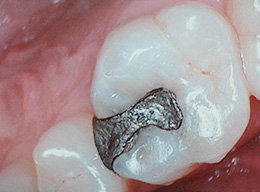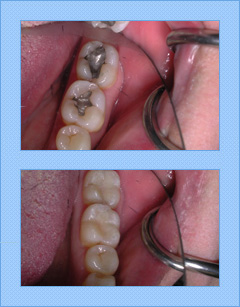Fillings

Traditional dental restorations (fillings) include gold, porcelain, composite, and amalgam. The strength and durability of traditional dental materials continue to make them useful for situations where restored teeth must withstand extreme forces that result from chewing, such as in the back of the mouth.
Newer dental fillings include ceramic and plastic materials that mimic the appearance of natural teeth. These compounds, often called composite resins, are usually used on the front teeth where a natural appearance is important. They are also used on the back teeth depending on the location and extent of the tooth decay. Composites are usually more costly than the older silver amalgam fillings because the procedure is technique sensitive and, therefore, requires more time.
What's Right for Me?
Several factors influence the performance, durability, longevity and expense of dental restorations:
- the components used in the filling material
- the amount of tooth structure remaining
- where and how the filling is placed
- the chewing load that the tooth will have to bear
- the length and number of visits needed to prepare and adjust the restored tooth

The ultimate decision about what to use is best determined in consultation with the dentist. Before your treatment begins, discuss the options with the dentist. To help you prepare for this discussion it is helpful to understand the two basic types of dental fillings: direct and indirect.
- Direct fillings are fillings placed immediately into a prepared cavity in a single visit. They include amalgam and composite (resin) fillings. The dentist prepares the tooth, places the filling, and adjusts it in one appointment.
- Indirect fillings generally require two or more visits. They include inlays, onlays, veneers, crowns, and bridges fabricated with gold, metal alloys, ceramics, or composites. During the first visit, the dentist prepares the tooth and makes an impression of the area to be restored. The dentist then places a temporary covering over the prepared tooth. The impression is sent to a dental laboratory which creates the dental restoration. At the next appointment, the dentist fits and cements or bonds the restoration into the prepared tooth and adjusts it as needed.
